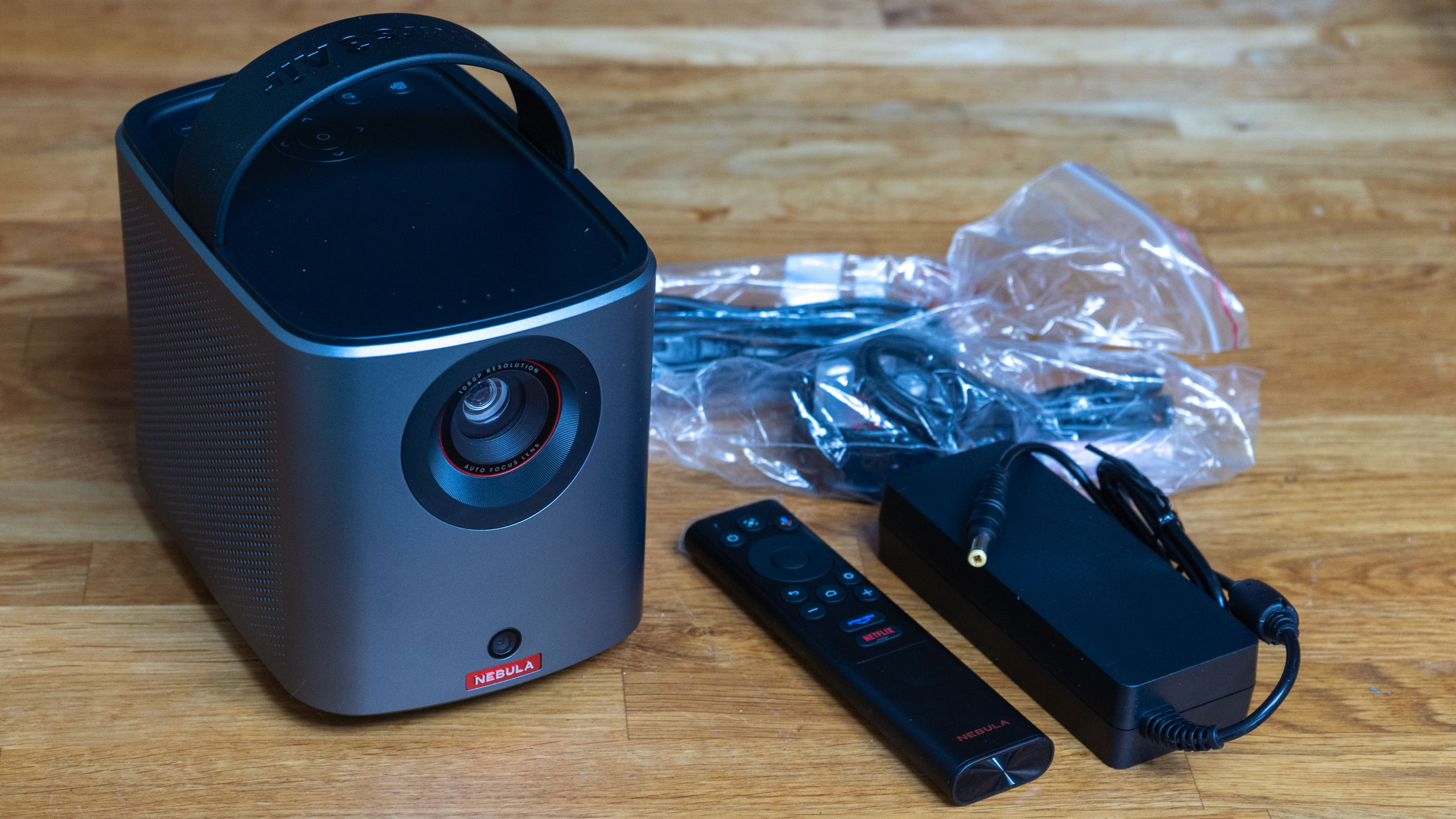Digital Camera World Verdict
A quality projector with graceful design, surprisingly good speakers, and brightness that'll turn a room into a cinema at a very accessible price point. The claimed battery life is slightly optimistic, and perhaps the system software could be a little snappier, but overall it feels like good value.
Pros
- +
Built-in carry handle
- +
Effective auto keystone correction
- +
App control
- +
Sharp image, even up to 150 inches
Cons
- -
No USB-C (for power)
- -
Not use in rooms with daylight
- -
No USB-C (for digital video)
Why you can trust Digital Camera World
The portable projector is an increasingly practical tool in the creative's toolkit; if you make videos there is much to be said for viewing them on the big screen (or reasonably white wall). Of course they're also great for watching movies and all your favourite video and indeed acting as a display if, like this, they have HDMI ports.
Native resolution: 1080P
Connectivity: Wi-fi, USB-A, HDMI, 3.5mm AUX
Throw: 1.2:1 ratio
Brightness: 400 ANSI lumens
Weight: 1.7kg / 3.75lb
The Nebula Mars 3 Air is one of quite an extensive range from Nebula, a brand belonging from Anker, and – like other higher-end portable projectors – it boasts 1080P native projection and, importantly, a battery, meaning you can use it without being plugged in. (One thing to note; Nebula's naming could have a little more variety – they also have a 'Mars 3', which is a different device).
What makes this device special too is that rather than running Android TV or any of the more obscure solutions I've tried on other portable projectors, Anker/Nebula provide Google TV so this device essentially acts like a smart TV (you can download all the apps, Prime, Apple TV etc.) and has very straightforward interface, especially if you're registered with Google or YouTube, and the Netflix app is included with official support so you don't even have to download it.
TV enthusiasts will also know that means we're looking at a device with voice control via Google Assistant though if you prefer there is also a phone app.
Build and handling
The Mars 3 Air has adopted a pretty straightforward rectangular block with handle approach to the design, though on closer inspection everything is designed and assembled with a notable sense of chic, from the bottom up.
Speaking of, there is a black plastic base plate with an array of vents spaying around where it meets the dark silver shell. Only a tripod screw hole (don't worry, that's metal) is cut from the base, while the shell – all four sides a single moulding – has cutouts at the back for a more serious vent with ports and switches at the top. At the opposite end is the projector lens itself, while at either side there are grids for the active cooling (fan).

Atop the device you'll find a a directional button, repeating the one on the remote, and – when powered up, four pinprick lights to indicate charge level. Arcing over that is the rubber handle with the name embossed. Additionally inside there is a motion sensor to trigger the automated keystone correction process (which is definitely more successful than some projectors I've tested, quicker and introducing less aliasing).
The best camera deals, reviews, product advice, and unmissable photography news, direct to your inbox!

The Nebula also has a remote control which which works via infra-red and (after pairing) Bluetooth – pretty much an industry standard for projectors. A nice touch is backlighting for some of the buttons. As Netflix is 'official' it gets its own button, as does Prime. There are also volume keys, though it'd be nice to see a traditional pause icon (yes, I'm old enough to remember VHS, DVD, Blu-Ray et. al. and don't like being sent to the menu all the time).
Some projectors have their own software, or attempt to layer Android TV so that you switch in and out of it. Google TV is different, and all the TV settings are fully integrated, not that there are actually that many options. That makes for very straightforward usability and in the vast majority of circumstances that's all you'll need.
There is, for example, a 60MHz 1080P gaming mode disables the trapezoid processing (keystoning) for absolutely the quickest response times – though you need to position the projector yourself.
Performance
The 400 ANSI lumens deliver a bright picture in a dim room, and the picture is notable for being even and sharp. Thanks to the throw ratio, you'll get an impressive image size even in a small room, and you'll certainly be happy up to 120-inches or so, though it'll happily focus past 150-inches and look fine in a dark space.
When I put the projector off-angle the automatic keystoning was impressively fast to correct and, in comparison to most projectors I've tested, the area of the image that wasn't being used was nicely dim. That's good evidence of good contrast from the LED light source which has a claimed service life of 30,000 (not something I can test!)
I was a little less impressed with the device's ability to detect objects which it is meant to be able to do but I didn't notice in practice, not that I've ever actually found this an especially useful feature.

The videos I tested were broadly encouraging. One scene which is great for testing the projector's quality is the dénouement of musical animation Sing 2, which asks a lot of the speakers, color, and detail as assorted animals of different sizes (with contrasty hair and spines aplenty) perform.
For a bit more human drama I also viewed the sequence in Sully shifting from air traffic control to externals of the aircraft. Here the dimmer areas seemed a little exaggerated to my eye, but to be fair I was testing on a white all – not a screen – at this point and I find the look quite cinematic. The only TV show that gave me any cause for concern in all my testing – though it might have been the Disney+ app – was Europe from Above, which has a lot of swooping drone shots. I'd swear I occasionally caught a few judders on these.

Verdict
This is a very good entertainment projector, with a sharp picture that has good overall quality, even near the edges, and one of the better auto-keystoning systems I've tested plus a battery which lives up to its promises. Google TV is great for entertainment, though the remote would benefit from a pause button.
While I do have my worries about the software, which I didn't find exactly laggy but definitely felt could be snappier, I think the projector would be far more flexible if, like a lot of modern phones, tablets, and laptops, it charged via a USB-C socket. I struggle to see why Anker didn't opt for that method since the cable can take the wattage needed (they can run a high-end laptop, after all) and the same connector can take a DisplayPort video signal from a computer or phone into the bargain. It wouldn't hurt Anker's battery business either!
If, however, you only want to watch one movie away from the power brick, then in my test the projector comfortably surpassed the 2 and a half hours promised for the battery when in eco mode, which is fine in lower light, making this well suited to occasional portability but less ideal for those needing input & power flexibility on the move.
Should you buy the Anker Mars 3 Air
✅ Buy this if...
- You want a battery projector with enough power for a feature film
- You want good quality built-in speakers
- You like the Google TV system with apps and voice controls
🚫 Don't buy this if...
- You want to charge with standard connectors
- You want to display 4K
- You want a good range of input ports
You might also like...
The Asus ZenBeam L2 is a pricier option in the same category and exactly same brightness, but it has two substantial improvements; it has USB-C port so you can charge without a dedicated brick, and the battery lasts longer.
The Emotn N1 is a cheap alternative that still has a 1080P image is also Netflix-approved, though lacks the Google TV and the battery – you'll need to find a power outlet, but it is reasonably quiet, has a good, bright image, wi-fi, and probably has the edge on sound too.

With over 20 years of expertise as a tech journalist, Adam brings a wealth of knowledge across a vast number of product categories, including timelapse cameras, home security cameras, NVR cameras, photography books, webcams, 3D printers and 3D scanners, borescopes, radar detectors… and, above all, drones.
Adam is our resident expert on all aspects of camera drones and drone photography, from buying guides on the best choices for aerial photographers of all ability levels to the latest rules and regulations on piloting drones.
He is the author of a number of books including The Complete Guide to Drones, The Smart Smart Home Handbook, 101 Tips for DSLR Video and The Drone Pilot's Handbook.




